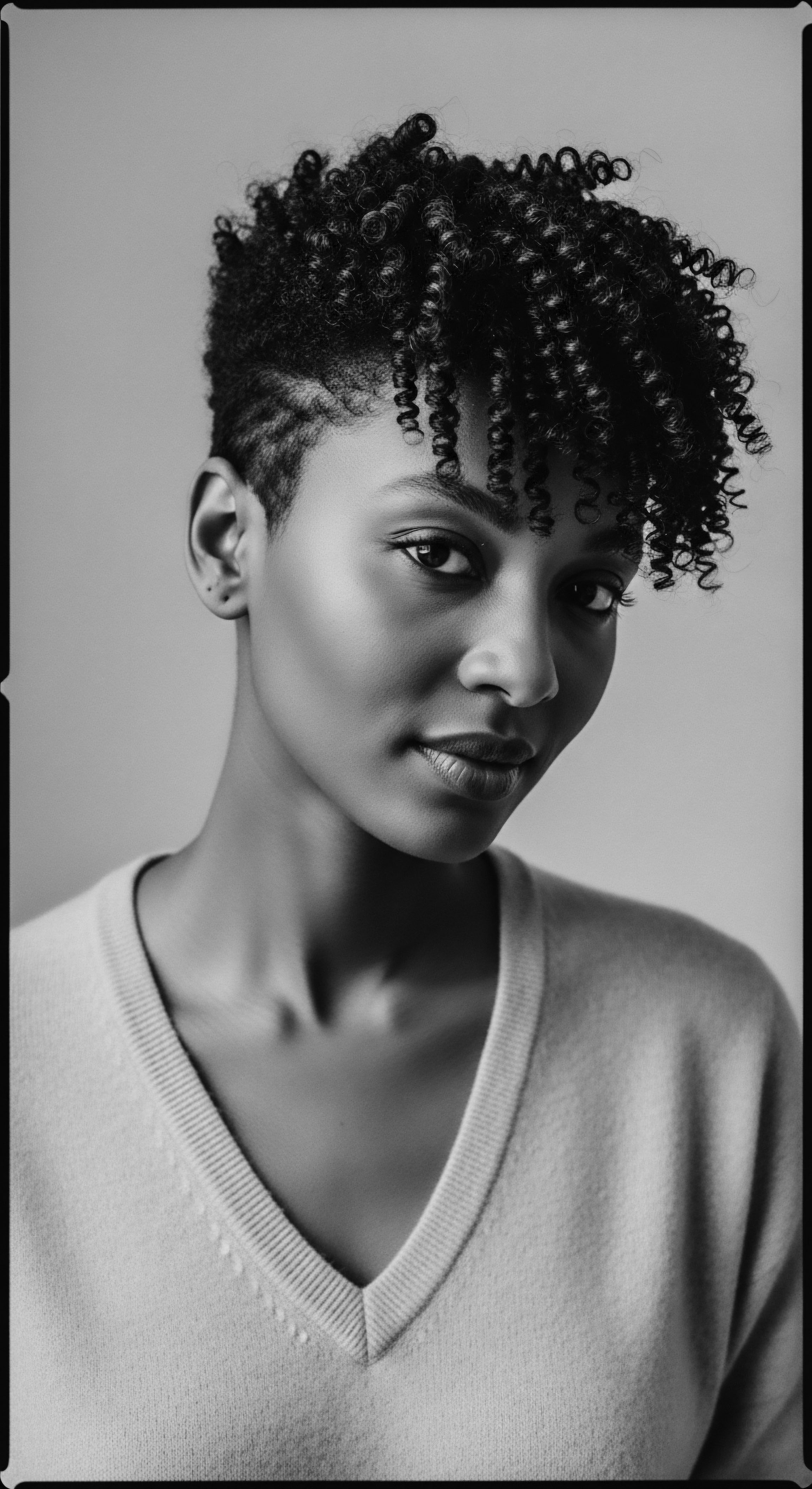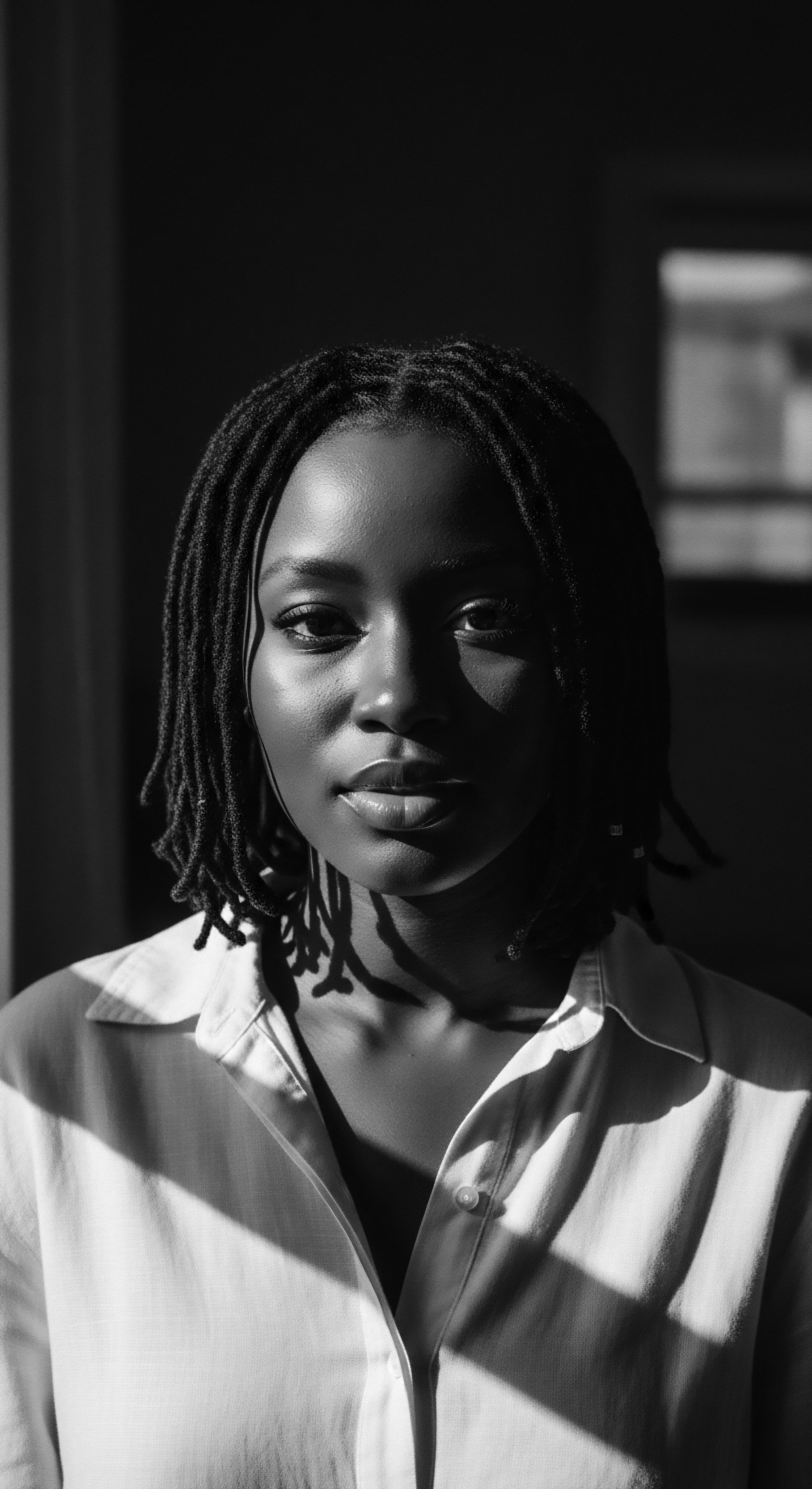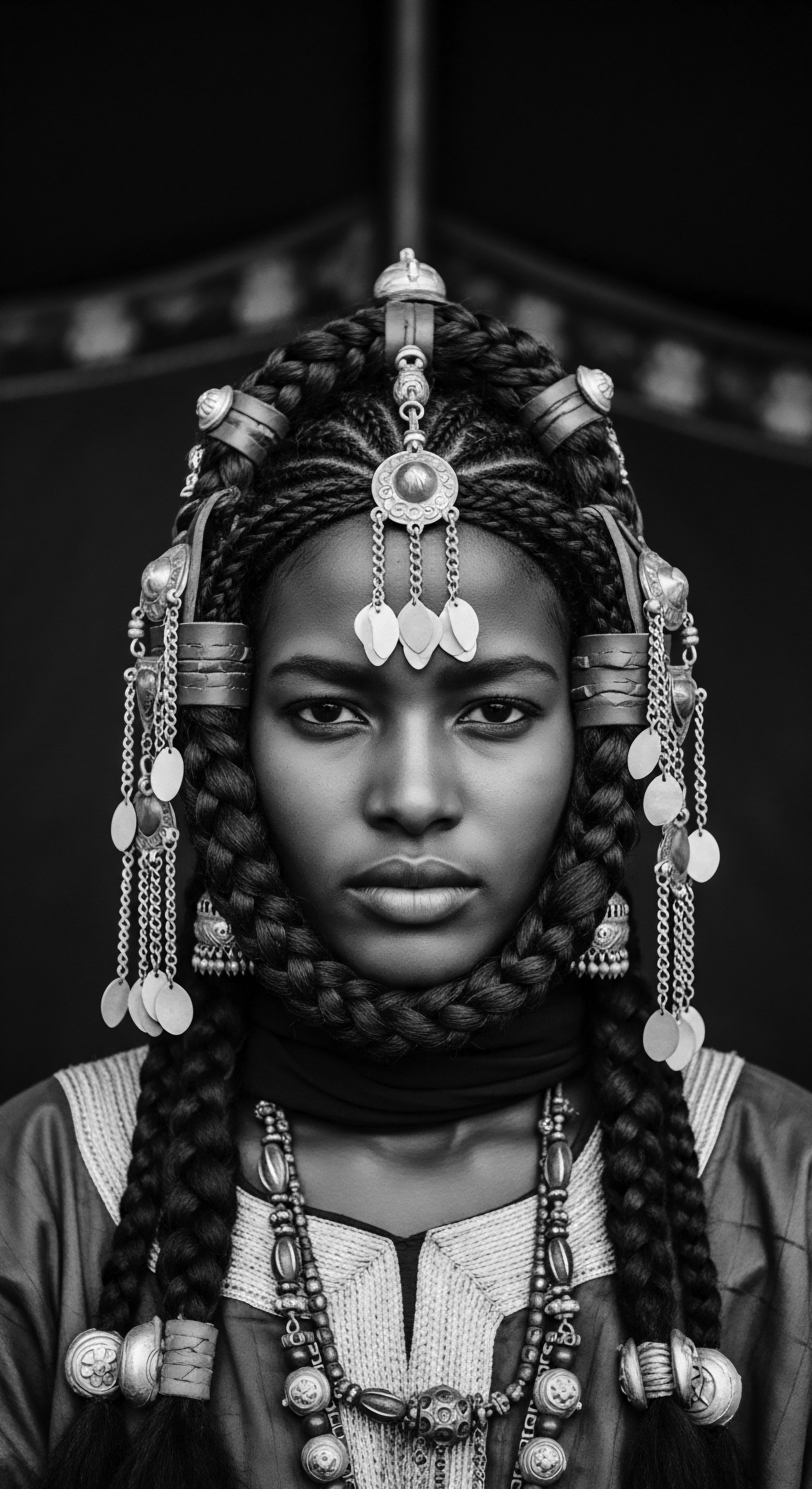
Fundamentals
The concept of Ancient Care, as inscribed within Roothea’s living library, represents far more than a simple regimen for hair; it is a profound echo from humanity’s earliest interactions with the natural world, particularly as these engagements shaped the reverence for textured hair. This foundational understanding begins with the very essence of hair itself – not merely as a biological outgrowth, but as a living fiber, deeply responsive to its environment and the hands that tend it. In its most elementary form, Ancient Care is the intuitive wisdom of tending to the scalp and strands with elements directly sourced from the earth, recognizing hair’s intrinsic connection to vitality and the rhythms of nature.
Consider the earliest whispers of care, predating recorded history. Human beings, observing the resilience of plants and the protective qualities of natural compounds, began to apply these observations to their own forms. For textured hair, with its unique helical structure and propensity for moisture loss, the discernment of beneficial natural substances was not a luxury, but a necessity for comfort and protection.
The very first instances of Ancient Care were likely pragmatic, born from a desire to shield hair from harsh sun, dust, and arid winds, or to alleviate scalp discomfort. Over time, these rudimentary applications transformed into deliberate practices, passed from one generation to the next, becoming interwoven with the very fabric of communal life.
The early forms of care were deeply tied to the local ecology. The sap of trees, the richness of plant oils, the cleansing properties of certain clays, and the soothing qualities of botanical infusions became the initial palette of Ancient Care. For communities across various landscapes, particularly those in African lands where textured hair is a prevailing characteristic, this knowledge was paramount.
The act of gathering these natural ingredients, preparing them, and applying them became a shared experience, strengthening bonds and solidifying a collective understanding of hair’s inherent needs. This elemental recognition of hair’s biology, understood through observation and ancestral experimentation, forms the bedrock of what we now delineate as Ancient Care.
Ancient Care, at its fundamental core, signifies the intuitive wisdom of tending to textured hair with elements directly sourced from the earth, acknowledging its intrinsic connection to vitality and the rhythms of nature.

Early Earth-Rooted Practices
The initial expressions of Ancient Care were often simple, yet deeply effective. They revolved around directly addressing the hair’s elemental needs for hydration, protection, and gentle cleansing. For instance, the use of water, collected from rain or fresh springs, for rinsing and softening the hair was universal. Beyond water, the application of various plant-based oils and butters became central to preventing dryness and breakage, common concerns for textured hair.
- Plant-Based Oils ❉ Early communities discovered the emollient properties of oils derived from seeds, nuts, and fruits. These included precursors to what we now recognize as shea butter, palm oil, and coconut oil, each offering protective layers and nourishing qualities.
- Clays and Earths ❉ Certain mineral-rich clays were utilized for cleansing the scalp, absorbing excess oils, and providing a detoxifying effect. Their natural properties offered a gentle alternative to harsh abrasives.
- Herbal Infusions ❉ Leaves, roots, and flowers were steeped in water to create infusions used for rinsing, conditioning, and imparting a subtle fragrance. These botanical preparations often held both practical and ceremonial significance.
These rudimentary methods, honed over countless generations, formed the earliest layer of knowledge surrounding hair maintenance. The hands that applied these natural remedies were often those of mothers, grandmothers, and community elders, imbuing each act of care with a sense of lineage and collective wisdom. The hair, therefore, was not simply an appendage; it was a recipient of shared heritage, a canvas for communal expression, and a living record of environmental adaptation. This fundamental understanding lays the groundwork for appreciating the deeper cultural and scientific dimensions of Ancient Care.

Intermediate
Moving beyond the elemental understanding, the intermediate interpretation of Ancient Care expands into the rich tapestry of human tradition, where the basic acts of tending hair transformed into intricate rituals and expressions of identity. Here, Ancient Care is not merely about physical application; it embodies the intergenerational transfer of knowledge, the communal bonds forged through shared grooming, and the symbolic meanings ascribed to hair within various cultures. This perspective acknowledges that the care of textured hair became a tender thread, weaving through the lives of individuals and communities, connecting them to their past and shaping their collective future.
Across diverse African societies and within the diaspora, hair was never a static entity; it was a dynamic medium for communication, a marker of social standing, age, marital status, and spiritual connection. The practices of Ancient Care evolved to reflect these deeper significances. The tools used, the patterns created, and the adornments chosen all carried specific connotations, understood by members of the community. This communal understanding transformed hair care from a personal task into a social event, often accompanied by storytelling, singing, and the sharing of wisdom.
Ancient Care, at an intermediate level, unveils the profound cultural significance of hair practices, where tending to textured hair became a tender thread weaving through community life, transferring ancestral knowledge and signifying identity.

The Tender Thread ❉ Community and Ritual
The communal aspect of Ancient Care is particularly striking. In many traditional African settings, hair grooming was a collective endeavor, performed by skilled hands within the family or community. This was not simply a matter of efficiency; it was a deliberate act of strengthening social ties.
Children learned the practices from their elders, observing the careful sectioning, the rhythmic braiding, and the precise application of natural compounds. This direct transmission of knowledge, devoid of written manuals, ensured the continuity of these practices for centuries.
The rituals surrounding hair were often imbued with spiritual meaning. Hair, being the highest point of the body, was frequently considered a conduit to the divine or a repository of ancestral wisdom. Thus, the act of styling or caring for hair was not taken lightly; it was a sacred practice, performed with respect and intention. The selection of specific herbs or oils for certain occasions, or the creation of particular hairstyles for rites of passage, all underscored the deep reverence for hair as a living, sacred part of the self.

Cultural Expressions and Hair as a Narrative
The diverse ways textured hair was styled served as a complex visual language. In many West African societies, for example, specific braid patterns could signify a person’s age, tribal affiliation, or even their marital status. The intricate designs were not random; they were carefully chosen narratives, telling stories about the individual and their place within the collective. This symbolic richness meant that hair care was an art form, a means of creative expression deeply rooted in cultural heritage.
Consider the Himba people of Namibia, whose distinctive hair practices exemplify this. Women coat their hair with a mixture of ochre, butter, and herbs, creating a rich, reddish hue that not only protects their hair from the harsh desert sun but also symbolizes their connection to the earth and their ancestors. This practice is a living testament to how Ancient Care transcends mere aesthetics, becoming a profound cultural statement. Similarly, the Fulani braids, often adorned with beads and cowrie shells, speak volumes about heritage and marital status in West African communities.
The journey of Ancient Care continued even through the profound disruptions of the transatlantic slave trade and colonialism. Stripped of their traditional tools and ingredients, enslaved Africans adapted, using whatever was available to maintain their hair, often as a quiet act of resistance and a way to preserve a connection to their ancestral identity. This resilience underscores the inherent value placed on hair care, even in the face of immense oppression. The memory of these traditional practices, though sometimes fragmented, persisted through generations, re-emerging in new forms and continuing to shape hair care traditions in the diaspora.
| Historical Context of Practice Braiding Patterns in West Africa |
| Traditional Purpose and Cultural Significance Signified age, tribal affiliation, social rank, or marital status; a form of visual communication and community bonding. |
| Contemporary Echoes and Adaptations Reclaimed as expressions of Black identity, cultural pride, and artistic expression; modern braiding salons serve as community hubs. |
| Historical Context of Practice Ochre and Butter Mixtures (Himba, Namibia) |
| Traditional Purpose and Cultural Significance Protection from sun and elements; symbolized connection to earth and ancestors; a marker of cultural identity. |
| Contemporary Echoes and Adaptations Inspiration for natural hair protective styles and ingredient choices; a reminder of hair as a spiritual and ancestral link. |
| Historical Context of Practice Communal Grooming Sessions (Various African Societies) |
| Traditional Purpose and Cultural Significance Strengthened social bonds; facilitated intergenerational knowledge transfer; a space for storytelling and collective well-being. |
| Contemporary Echoes and Adaptations Natural hair meet-ups, online communities, and shared styling experiences that foster connection and education within the diaspora. |
| Historical Context of Practice Natural Oils and Butters (e.g. Shea, Palm, Coconut) |
| Traditional Purpose and Cultural Significance Nourishment, moisture retention, and protection for hair and scalp; integral to daily care and ritual. |
| Contemporary Echoes and Adaptations Cornerstones of modern natural hair product formulations; celebrated for their effectiveness and ancestral authenticity. |
| Historical Context of Practice These practices illuminate the enduring legacy of Ancient Care, demonstrating its adaptability and profound meaning across generations and geographies. |
The evolution of Ancient Care is a testament to the adaptability and ingenuity of human communities, particularly those with textured hair, who continually sought to understand and honor their strands. This intermediate exploration reveals that the practices were not static but fluid, adapting to new environments and challenges, yet always retaining their core purpose ❉ to nourish, protect, and celebrate hair as a vital part of cultural and individual identity.

Academic
The academic delineation of Ancient Care transcends simplistic definitions, positioning it as a sophisticated, historically layered, and culturally specific body of knowledge concerning the biophysical and psychosocial dimensions of textured hair. This interpretation demands a rigorous examination, drawing from ethnobotany, cultural anthropology, historical sociology, and trichology, to reveal the intricate interplay between ancestral wisdom, environmental adaptation, and the enduring quest for holistic well-being through hair. It is within this academic lens that we perceive Ancient Care not as a collection of antiquated practices, but as a dynamic system of care, profoundly shaped by the unique biological characteristics of textured hair and the socio-cultural landscapes in which it flourished.
The meaning of Ancient Care, at this elevated level of scholarly inquiry, encompasses the deep understanding of botanical properties, the biomechanics of coily and kinky strands, and the intricate social structures that historically governed hair adornment and maintenance. It is a concept that acknowledges the systemic nature of traditional knowledge, where each ingredient and technique was chosen with purpose, often reflecting a nuanced grasp of hair’s needs that modern science is only now beginning to fully apprehend. This comprehensive view recognizes the resilience inherent in textured hair traditions, which persisted and adapted even through periods of profound disruption, such as the transatlantic slave trade and the imposition of Eurocentric beauty standards.
The academic meaning of Ancient Care represents a sophisticated, historically layered body of knowledge concerning the biophysical and psychosocial dimensions of textured hair, integrating ancestral wisdom with environmental adaptation and the enduring quest for holistic well-being.

Echoes from the Source ❉ Biophysical Understanding and Ancestral Ingenuity
From a biological standpoint, textured hair, characterized by its elliptical follicle shape and multiple twists and turns along the hair shaft, presents unique challenges related to moisture retention and fragility. Ancient Care, in its most astute forms, developed methods to address these inherent qualities. The selection of ingredients was often based on observed properties ❉ emollients for moisture, natural astringents for scalp health, and protective agents against environmental stressors. This intuitive ethnobotanical knowledge, refined over millennia, formed a practical science long before formal laboratories existed.
Consider the profound wisdom embedded in the use of Chebe powder by the Basara women of Chad. This practice, dating back at least 7,000 years, according to Salwa Petersen, a founder of a beauty line specializing in Chébé, represents a powerful historical example of Ancient Care’s connection to textured hair heritage. The powder, derived from the seeds of the Croton zambesicus plant, is traditionally mixed with oils and applied to the hair, forming a protective layer that helps retain moisture and prevent breakage. This is not a casual application; it is a meticulously preserved ritual, passed down through generations, contributing to the Basara women’s renowned long, strong hair.
The consistent application of this mixture to the hair shaft, often braided for added protection, allows the hair to reach impressive lengths by minimizing mechanical damage and sealing in hydration. This exemplifies a deep, empirical understanding of hair biology and protective styling long before modern trichology provided scientific explanations for length retention in textured hair. The cultural significance of Chebe powder extends beyond mere hair length; it is a symbol of womanhood, fertility, and beauty within the Basara tribe, reinforcing the inseparable link between hair care, identity, and ancestral practice.
The application method itself, often involving communal sessions where mothers, sisters, and daughters apply the mixture to each other’s hair, underscores the social dimension of Ancient Care. This shared act fosters familial bonds and serves as a direct conduit for transmitting traditional knowledge, songs, and stories. The deliberate choice to avoid applying the mixture directly to the scalp, preventing buildup and potential irritation, also speaks to a sophisticated, experience-based understanding of scalp health. This particular example of Chebe powder highlights how Ancient Care practices were often holistic, addressing not only the physical needs of the hair but also reinforcing cultural identity and community cohesion.

The Unbound Helix ❉ Identity, Resilience, and Future Trajectories
The academic lens also allows for a critical examination of how Ancient Care practices have been impacted by historical forces, particularly the legacies of colonialism and slavery. During these periods, traditional hair care tools and methods were often stripped away, and textured hair itself became a target of dehumanization and a marker of inferiority. Enslaved Africans were forced to adapt, using whatever limited resources were available—such as cooking grease or animal fats—to care for their hair, often in secret, as a quiet act of defiance and cultural preservation. This historical context underscores the profound resilience embedded within Ancient Care, as communities found ways to maintain a connection to their hair heritage even under extreme duress.
The persistence of these practices, albeit sometimes in modified forms, demonstrates the inherent value placed on textured hair as a symbol of identity and resistance. The natural hair movement of recent decades, particularly within the Black diaspora, represents a reclamation of these ancestral traditions, a conscious rejection of Eurocentric beauty standards, and a celebration of the diverse textures of Black and mixed-race hair. This contemporary resurgence of Ancient Care principles, often manifested through the widespread use of natural ingredients like shea butter and traditional styling methods, signifies a powerful return to ancestral wisdom, affirming the profound cultural and personal liberation found in embracing one’s natural hair.
Academically, Ancient Care invites further exploration into its neurobiological and psychological impacts. The rhythmic motions of braiding, the sensory experience of natural oils, and the communal aspect of grooming sessions may have contributed to stress reduction, fostered a sense of belonging, and enhanced self-perception. These elements, though not always explicitly articulated in ancient texts, represent a holistic approach to well-being that transcends mere physical appearance. The long-term consequences of consistent, gentle care, coupled with the affirming cultural context, likely contributed to stronger hair and a stronger sense of self.
The academic investigation into Ancient Care reveals a rich tapestry of human ingenuity, cultural perseverance, and an intuitive scientific understanding of textured hair. It compels us to recognize the profound meaning embedded in ancestral practices, which continue to shape contemporary hair care, serving as a testament to the enduring power of heritage in defining beauty, identity, and collective resilience.

Reflection on the Heritage of Ancient Care
As we close this exploration of Ancient Care, the whispers from the past do not fade; they echo with amplified clarity, reminding us that the story of textured hair is an unbound helix, continuously spiraling through time. The profound wisdom of ancestral practices, born from deep observation and an intimate connection to the earth, continues to inform and inspire our present. Ancient Care is not a static artifact of history; it is a living, breathing testament to the ingenuity, resilience, and enduring spirit of communities, particularly those of Black and mixed-race heritage, who understood hair as a sacred extension of self and lineage.
The journey from elemental biology to the intricate cultural narratives woven into each strand reveals a consistent truth ❉ hair care, at its most authentic, is a holistic endeavor. It is about more than external adornment; it is about nourishing the scalp, strengthening the strands, and, crucially, feeding the spirit. The communal rituals, the specific botanical choices, and the symbolic language of hairstyles were all expressions of a profound reverence for textured hair, a reverence that persisted even through the darkest chapters of history.
The story of textured hair is an unbound helix, continuously spiraling through time, reflecting the ingenuity, resilience, and enduring spirit of communities who understood hair as a sacred extension of self and lineage.
The Soul of a Strand ethos, which guides Roothea’s very existence, finds its deepest affirmation in the principles of Ancient Care. It speaks to the recognition that every coil, every kink, every wave carries the memory of generations, a silent narrative of survival, creativity, and self-definition. By understanding and honoring these ancestral practices, we not only restore the vitality of our hair but also reconnect with a heritage that is rich, powerful, and endlessly inspiring. The future of textured hair care, therefore, is not a departure from the past but a harmonious return, a conscious decision to listen to the echoes from the source and allow that ancient wisdom to guide our hands, our choices, and our collective journey towards unapologetic beauty and profound well-being.

References
- Ouédraogo, A. Lykke, A. M. Lankoandé, B. & Korbéogo, G. (2013). Potentials for Promoting Oil Products Identified from Traditional Knowledge of Native Trees in Burkina Faso. Ethnobotany Research and Applications, 11, 071–083.
- Matjila, C. R. (2020). The meaning of hair for Southern African Black women. Submitted in fulfilment of the requirements for the degree of Master of Arts in Anthropology, University of the Free State.
- Nyamnjoh, F. and Fuh, D. (2014). Africans consuming hair, Africans consumed by hair. Africa Insight, 44(1), 52-68.
- Nnoruka, N.E. (2005). Hair loss ❉ is there a relationship with hair care practices in Nigeria?. International Journal of Dermatology, 44, 13-17.
- Oforiwa, A. (2023). The History and Culture of African Natural Hair ❉ From Ancient Times to Modern Trends. AMAKA Studio.
- Petersen, S. (2022, May 14). Chébé Powder’s Ancient Roots Could Be The Key To Long, Strong Hair. The Zoe Report.
- Chrisam Naturals. (2024, November 7). Chebe Powder for Hair Growth and Health. Chrisam Naturals.
- Assendelft. (n.d.). Unlocking the Secrets of Chebe Powder from Chad ❉ Benefits and Uses. Assendelft.
- Afriklens. (2025, April 12). How African Hairstyles Reflect Identity ❉ and Heritage. Afriklens.
- Our Ancestories. (2025, April 4). Braids, Beads, and Beauty ❉ Exploring African Hair Traditions With Your. Our Ancestories.
